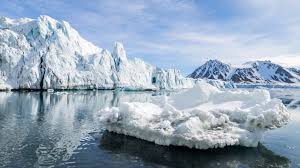The Future of the Arctic
It goes without saying that climate change will have multiple negative impacts on humanity. Rising sea levels could put many cities, such as New York and Boston, partially or totally underwater. Millions of species could potentially go extinct. Melting sea ice could render great and impressive animals, such as Polar Bears and Walruses, wiped out due to habitat loss.
Geopolitical trouble, however, is just getting started. As sea ice in the Arctic melts, once unreachable deposits of natural gas and oil are now accessible, resulting in potential competition over resources in the Arctic ocean. Around 47.3 trillion cubic meters of natural gas and 90 billion barrels of oil lie offshore, much of it deep within the Arctic Ocean, and outside any economic exclusion zone (EEZ)-which is 200 nautical miles from a country's shore. These vast resources, therefore, lie in competition between the six countries that border the Arctic (The US, Canada, Russia, Norway, Denmark, and Iceland), and the dispute appears to have broken into NATO countries against Russia. Currently, Russia appears to have a major edge.
Russia has undergone a drastic military buildup in the Arctic over the past few years. This includes a new Arctic command, 16 new deepwater ports, 14 new airfields, and has rebuilt military bases in the Arctic region. More importantly, Russia has 40 icebreakers in the Arctic (vital for navigation) compared to just one working icebreaker for the United States. Senator Dan Sullivan of Alaska is quoted as saying that “The highways of the Arctic are icebreakers”-meaning that the US is at a huge disadvantage to Russia when it comes to the Arctic. Additionally, Russia has expanded Arctic infrastructure, building new rail and road links to Russia’s industrial base.
The melting of the sea ice has also allowed for new maritime trade routes in the Arctic region. From ports in China and Japan, this trade route is around ⅓ shorter than the typical route, which involves going through the Indian Ocean, Suez Canal, and Mediterranean Sea. The entire Northern Sea Route lies in Russia’s EEZ, which presents a large geopolitical advantage to the Russian Federation.
In the Arctic Circle, there are no governing treaties. Instead, the Arctic Council provides a forum for nations to discuss Arctic policy. However, the Arctic Council has no regulatory power, which therefore leaves the entire Arctic as open for competition. This, combined with Donald Trump’s efforts to deregulate the oil and gas industries, could potentially lead to a new cold war in the Arctic. Both the United States and Russia are seeking to further militarize the Arctic, with new icebreakers and military bases.
Trump and the US government are under serious pressure to catch up with Russia by building new icebreakers and placing more military assets in the Arctic Circle. Even China has begun to build icebreakers, and although these icebreakers are meant for the south pole, it isn’t impossible to see China deploying icebreakers to the North Pole as well. With Russia attempting to put up a new “Ice Curtain” in this frigid region, the US has a clear need to act with urgency.



Comments
Post a Comment